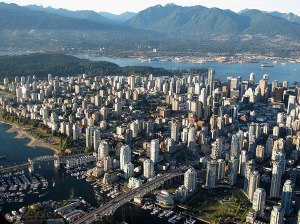Let’s face it, cities are running out of affordable housing. To spread out into more and more far-flung suburbs is very expensive. You need more amenities, schools, parks, hydro, sewers, transit lines and on and on. It makes more sense that people fill in the existing neighbourhoods so more people can live there. One of the answers is laneway homes but it would be too simplistic to suppose that it’s the only answer. Other means of densification must be found.
Let’s look at the facts. As we know, there are lies, damn lies, and statistics. As this article in the Tyee shows, the current “trend” toward stabilization in the housing market in Vancouver is actually a continuing crisis.
In Vancouver, nearly half of us (46 per cent) are paying more for lodging than we can afford, at least according to the official definition. But some analysts warn that even these numbers could be understating the problem.
The statistics that lie to us are questionable because
the elimination of the mandatory long-form survey dealt an insurmountable blow to accurate data collection.
So when some people refer to Vancouver housing prices, they actually mean
everything from West Vancouver to Langley and all the way down to White Rock.
But here in the City of Vancouver we are running out of affordable housing. Fast. And densification seems the logical answer.
But while many people complain about Vancouver’s expensive housing, to just as many “density is a bad word,” notes Anne Mullin, president & CEO of the Urban Development Institute (UDI), which represents Canadian developers. “But it’s an important discussion to have.”
She’s alluding to neighbourhood uprisings that have blossomed across Vancouver against city hall’s efforts to boost density. Marpole residents, for instance, blocked a “thin streets” proposal to allow more houses per lot. Grandview-Woodland neighbours became incensed at the idea of high-rise towers being added to the bustling transit hub at Commercial and Broadway.
The answers are out there, let’s take a look at what’s happening in other cities. Both are sea ports. Both are first world communities. And both are facing the same kind of problem as Vancouver is — a lack of affordable housing.
In Sydney, Australia, families are turning away from condos and
$2,000 a quarter in strata fees, with remodelling, pet ownership and even visible decor frequently regulated.
In Australia properties are sold in auctions, and you can bet the prices get pushed up on attractive houses, even tiny ones.
Over 70 people turned out for the auction of a one-bedroom house on a 114 square metre block in Darlington, which fetched $951,000 — well over the suburb’s median house price of $757,000.
That’s about 1225 square feet in size.
The listing for a 139 square metre space in Balmain, which sold for $825,000, suggested that buyers could maximise the floor plan by building a second level.
A 300 square metre fibro cottage in Annandale, marketed as needing “a major overhaul”, sold for a cool $900,000.
Those are Vancouver prices! And it doesn’t really add to affordability in neighbourhoods, rather is makes it worse by driving up the prices of the homes that are available.
In Seattle some developers are building “APodMents” — rooming houses with tiny apartments and shared amenities
One aPodment development, the Solana, has units that average 170 sq ft according to Seattle Mayor Mike McGinn, who has expressed his support of the developments (some units in other building are as small as 100 sq ft). The units come furnished (with no murphy beds so far as we know) and have their own bathroom and shower. Instead of a proper kitchen, they feature a fridge and microwave, with available communal kitchens. All utilities including wifi are included.
To say these buildings are experiencing push back is a gross understatement. People owning houses worth millions are suddenly findings these developments sprouting up along their blocks. And they are not happy.
Anyone who can scrape up enough money for month-to-month rent can live there…I don’t think most people want to live next to a boarding house with itinerant people living in it.
But in reality, tenants are not the usual SRO crowd
The various articles we scanned reported of young Microsoft employees, recent college grads and divorcees on a fixed income occupying these apartments–not thugs looking for launchpads for heists.
Once again we see that if we are going to offer affordable housing for the people who pour our lattes, sell us our groceries and our clothes, teach our children and attend our universities, we are going to have to accept higher densification in all neighbourhoods. Can we really say “Not In My Back Yard”?

Pingback: Pushback on small apartments in Portlandia | The Lady Who Lives Down the Lane